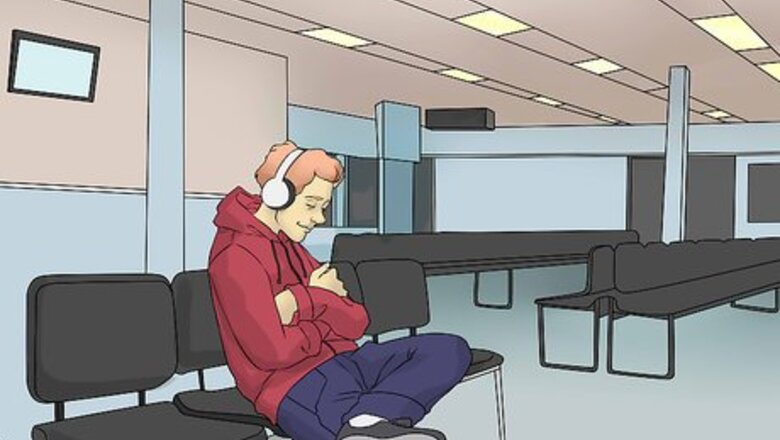
views
Passing the Driving Test

Arrive to your appointment early. You never know when traffic or some other unpleasant surprise might cause you to be late. Additionally, feeling rushed to get to your test on time can make you even more anxious. A moment to calm yourself could significantly improve your test results. When you arrive early, you'll have extra time to do things that relax you, like listening to music, reading a book, drinking a cup of coffee, and so on.

Present the necessary documents to the testing agent. In addition to your license, inspection, and registration, you'll also have to present a valid form of state issued ID. After these documents have been verified by the agent, your vehicle assessment will begin. Valid forms of primary ID include: state driver's license or ID card not yet expired two years, valid passport, permanent resident card, temporary resident card, unexpired military IDs, and more. The vehicle assessment portion of the test will only involve your testing agent checking that your vehicle is safe and legal. You likely won't be asked questions at this point unless something is wrong.

Ask questions before starting the driving test. Different testing locations may have a different setup, and you may want to inquire with your testing agent about the course or the agent's expectations. However, once you begin the driving test, the agent is generally not permitted to carry on casual conversation.

Make car adjustments before starting the car. Right when you hop in the car, your testing agent will be watching to see if you perform your pre-start duties. These involve adjusting the mirrors, your seat, fastening your seatbelt, and knowing the car controls. Even if your car is already adjusted to your comfort, make small adjustments to show that you have good driving habits. Some testing agents can be very strict about the order of the test. Check with your testing agent before getting into your car, making adjustments, and turning it on.

Demonstrate your ability in the four main skill areas. Your testing agent will evaluate your driving test with regard to control, observation, positioning, and signaling. Failing to do these legally and safely will result in points, and too many points result in failing the test. Control relates to how well you are able to make the car do what you intend. For example, putting the car in reverse when you meant to put it in drive or struggling to turn cleanly would indicate poor control. A good score in observation will come from you always keeping traffic in view and responding to potential problems proactively. Your positioning score will depend on your ability to stay in your lane consistently. Drifting, weaving, or favoring one side of the lane over another will hurt this score. As long as you always remember to use your turn signals where appropriate, you can expect a strong score in this skill area.

Prove your basic driving proficiency. This includes many things, all of which should have been covered in your driver's education course. The exact areas you are tested on can vary, though there are some features you can expect on nearly any driving test. These include: Parallel parking Backing up your vehicle for 15 feet in a straight line Defensive driving Obeying all traffic signs and signals, especially stop signs Stopping quickly from a speed of 20 mph without skidding the tires Keeping proper posture, with both hands on the wheel at all times

Receive your results. After your test is finished, the testing agent will inform you whether or not you passed the test. Following this, you can expect detailed feedback on your driving strengths and weaknesses. If you didn't pass this time around, you still have 90 days to try two more times to pass the test. If 90 days have passed since your last driving test, or if you've failed the test three times in 90 days, you'll have to file a new application and pay the application fee once again.
Overcoming Driving Test Anxiety

Make a practice test. With a few cones or other place markers, like boxes, you can create your own practice driving test in your driveway, yard, or in an empty parking lot. You should especially target trouble areas for practice, like parallel parking. To create a test spot for parallel parking, set two cones or markers 25 feet apart from each other and 8 feet from the curb. When you park your car, you'll want your wheels to end up 6-18 inches from the curb.

Coach yourself through anxiety. Nerves from your driving test might make you overly critical of your ability and hurt your performance. When you feel anxiety, confront it directly and mentally encourage yourself. For example, you might say something like: "It's only natural to be nervous. Lots of people get nervous about tests. I've worked hard and am a careful driver. I can do this!" "I don't usually feel nervous when driving. I'm going to do my best, and if I need to, I can always take it again."

Take your time. As long as you are performing your driving maneuvers safely and legally, you don't need to rush to make a turn, merge into a lane, or pull into a parking spot. Similarly, take your time answering any oral questions during the driving test. It's better to take your time and do things properly than rush and get a worse score.

Remember to breathe. When you get nervous or anxious, without realizing it you might end up holding your breath or breathing shallowly. This can make you feel worse. Take deep, full breaths slowly to help calm yourself during the test. Stress related shallow breathing can cause panic attacks in some people. Stop panic attacks before they start by regulating your breathing with deep, full breaths. Breathing in and out on a count can also help you calm yourself. For example, you might breathe in slowly and completely while counting to ten, hold the breath for a moment, then breathe out slowly and completely, again while counting to ten.
Meeting Preliminary Requirements

Complete a course in driver's education. If you are under 25 years old, you'll have to complete a driver's education course before you can even take the driving test. You can begin the course as young as 14, but you won't be able to apply for your learner's permit until you are at least 15. If you are over 18 and have a valid license, or if you have a valid license from another state, you won't be required to take a driving portion of the test, though it could be requested by DPS. Those under 18, however, are required to take the test, even with a valid license. There are a few different options available for you driver's training. You could learn at a for-profit driving school, a public school driving program, or a parent taught version, too.

Fulfill your practice hours. After completing your classroom hours and passing the written exam for your learner's permit, you'll need to put in some practice time. Before your driving test, you'll need to have had your permit for at least six months, practiced at least 30 hours behind the wheel, and turned 16 years old. When you take and pass the test, you get your provisional license. Provisional licenses are generally for young drivers over the age of 16 but under 18. These licenses have some restrictions until you turn 18, when you will be issued your official license. Driving examiners look for smooth, consistent skills that demonstrate safety in different settings. Just like learning a new sport or an instrument, it takes a lot of time on task to be proficient in driving.

Schedule your appointment. Since driving tests are administered by DPS, you'll have to make an appointment at your local DPS office. In most cases, this can be done on the official Texas DPS homepage under the "More Online Services" tab. Choose a time of day that you're alert and at your best. For example, if you're a morning person, you might want to schedule your appointment earlier in the day. You may want to avoid scheduling your test for rush hour or lunch time. Increased traffic can add unnecessary stress to your test.

Assess your vehicle before the test. Before you begin the test, the testing agent will check that your car is safe and legal to drive. Failing any one part of the vehicle assessment could result in you failing the test, even if your driving is perfect. Be sure your car has: Two license plates permanently attached to the front and back of the car, excluding out-of-state and temporary plates. A working speedometer, horn, front and back turn signals, seatbelts, wipers, headlights, brake lights, and taillights. A minimum of one review mirror, either inside or outside the vehicle, and a front passenger door that opens normally both inside and outside. Current registration, inspection, and insurance. Be careful where insurance is concerned. You cannot be listed as an "excluded driver."




















Comments
0 comment